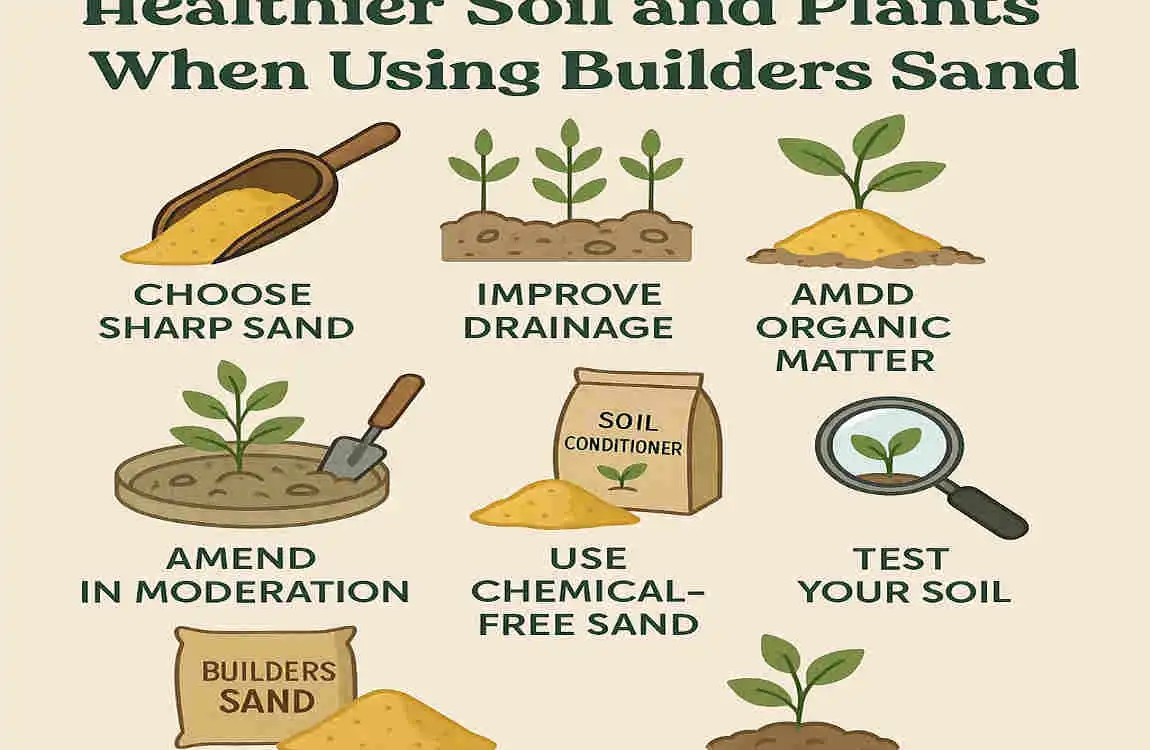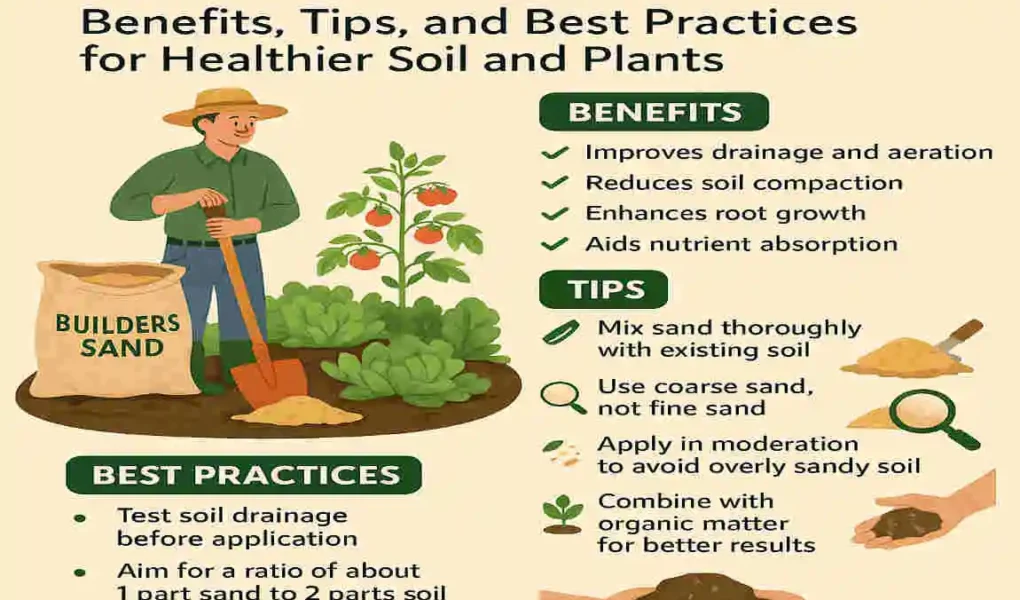Builder’s sand, often seen at construction sites, is an unlikely candidate for your home garden. But can you really use it to improve your soil? Let’s dive into this intriguing question and explore the ins and outs of using builders’ sand in your garden.
Soil quality is crucial for any successful garden. It affects everything from plant growth to root health. In this article, we’ll take a closer look at builders’ sand and its potential role in your garden. We’ll cover the benefits, tips, and best practices for using this sand effectively.
What Is Builders’ Sand?

Definition and Characteristics
Builders’ sand, also known as sharp sand or coarse sand, is a type of sand commonly used in construction. It’s characterized by its rough texture and larger grain size compared to other sands. This sand is typically quarried and composed of angular grains.
Comparison with Other Types of Sand
Builders’ sand differs from other types of sand in several ways:
- Horticultural sand: This sand is specifically designed for gardening and has a finer texture than builders’ sand.
- Play sand: Used in sandboxes and playgrounds, it is much finer and softer than builders’ sand.
- Sharp sand: Similar to builders’ sand, sharp sand is often used in construction and has a similar texture and grain size.
Common Uses in Construction vs. Gardening
In construction, builders’ sand is used for various purposes, such as mixing concrete, laying bricks, and creating a base for paving. In gardening, it can be used to improve soil drainage and aeration, but its suitability depends on several factors, which we’ll explore in the following sections.
Understanding Soil Composition and Why Sand Matters in Gardens
Basic Components of Healthy Garden Soil
Healthy garden soil is made up of four main components:
- Clay: Provides structure and nutrient retention
- Silt: Helps with water retention and nutrient availability
- Sand: Improves drainage and aeration
- Organic matter: Supplies nutrients and improves soil structure
Role of Sand in Improving Soil Drainage and Aeration
Sand plays a crucial role in improving soil drainage and aeration. Its larger particles create spaces, allowing water to flow more easily through the soil. This helps prevent waterlogging and root rot, which can be detrimental to plant health.
How Soil Texture Affects Plant Growth and Root Health
Soil texture, determined by the proportions of clay, silt, and sand, directly impacts plant growth and root health. Sandy soils drain quickly but may not retain enough nutrients, while clay-heavy soils can become compacted and waterlogged. A balanced soil texture is essential for optimal plant growth.
Can You Use Builders’ Sand in the Home Garden?
Direct Answer to the Focus Question
Yes, you can use builders’ sand in your home garden, but with caution and under the right conditions.
Scientific and Practical Reasoning Behind the Suitability or Unsuitability
Builder’s sand can improve soil drainage and aeration, particularly in clay-heavy soils. However, its suitability depends on factors such as the sand’s quality, the existing soil composition, and your plants’ specific needs.
When Builders’ Sand Can Be Used Safely in Gardens
Builders’ sand can be used safely in gardens when:
- The sand is free of contaminants and salts.
- It’s used in the right proportions with existing soil.
- It’s incorporated correctly to avoid compaction.
Potential Risks of Using Builders’ Sand
While builders’ sand can be beneficial, there are potential risks to consider:
- Contaminants: Builders’ sand may contain harmful substances, such as heavy metals or construction-site chemicals.
- Compaction: If not appropriately mixed, builders’ sand can lead to soil compaction, hindering root growth.
- Salt content: Some builders’ sand may contain high levels of salt, which can be detrimental to plant health.
Benefits of Using Builders’ Sand in Your Garden Soil
Improved Soil Drainage, Especially in Clay-Heavy Soils
One of the main benefits of using builders’ sand in your garden is improved soil drainage. Clay-heavy soils can become waterlogged, leading to root rot and other issues. Adding builders’ sand can create a more balanced soil texture and improve drainage.
Prevention of Waterlogging and Root Rot
By improving soil drainage, builders’ sand helps prevent waterlogging and root rot. When water can flow freely through the soil, roots have access to the oxygen they need to thrive.
Enhancing Soil Aeration for Stronger Root Systems
Builders’ sand also enhances soil aeration, which is essential for strong root systems. As the sand particles create spaces between them, air can circulate more easily through the soil, promoting healthy root growth.
How It Helps in Creating Suitable Seedbeds or Planting Mixes
Builder’s sand can be used to create suitable seedbeds or planting mixes. Its coarse texture helps prevent soil compaction, allowing young roots to penetrate easily. When mixed with other components, such as compost or peat moss, builders’ sand can create an ideal growing medium for seedlings and young plants.
Tips for Using Builders’ Sand Effectively in the Home Garden
How to Test Builders’ Sand Quality Before Use
Before using builders’ sand in your garden, it’s essential to test its quality. You can do this by:
- Checking for contaminants: Look for any visible signs of debris, chemicals, or other harmful substances.
- Testing for salt content: Use a simple salt test kit to ensure the sand’s salt levels are within a safe range for plants.
- Assessing texture and grain size: Ensure the sand has the appropriate texture and grain size for your gardening needs.
Recommended Proportions for Mixing with Garden Soil
The ideal proportion of builders’ sand to mix with your garden soil depends on your soil’s existing composition and your plants’ needs. As a general guideline, start with a 1:4 ratio of sand to soil and adjust as needed based on your soil’s response.
Best Techniques for Incorporating Sand into Existing Soil
To incorporate builders’ sand effectively into your existing soil:
- Dig and mix: Dig to the desired depth, then thoroughly mix the sand into the existing soil.
- Layer and till: Add a layer of sand on top of the soil, then use a tiller or garden fork to mix it in.
- Create a raised bed: If your soil is particularly heavy or compacted, consider creating one with a mix of sand, compost, and topsoil.
Types of Plants That Benefit Most from Sandy Soil Amendments
Certain plants thrive in sandy soil conditions and may benefit most from builders’ sand amendments:
- Cacti and succulents: These plants prefer well-draining soil and can tolerate the lower nutrient levels often found in sandy soils.
- Root vegetables: Carrots, radishes, and other root vegetables grow well in loose, sandy soil that allows for easy root penetration.
- Herbs: Many herbs, such as rosemary and thyme, prefer well-draining soil and can benefit from the improved aeration provided by builders’ sand.
Alternatives to Builders’ Sand in Gardening
Overview of Horticultural Sand and Its Advantages
Horticultural sand is a type of sand specifically designed for gardening. It has a finer texture than builders’ sand and is often washed to remove any contaminants. Horticultural sand can be used in potting mixes, seed starting, and as a top dressing for lawns.
When to Choose Sharp Sand or Coarse Sand Instead
Sharp sand or coarse sand may be a better choice than builders‘ sand in certain situations:
- When working with delicate plants, sharp sand’s finer texture may be more suitable for plants that require a gentler soil amendment.
- In potting mixes, coarse sand can be used to improve drainage without the risk of compaction associated with builders’ sand.
Pros and Cons Compared to Builders Sand
Sand Type Pros Cons
Builders Sand – Improves soil drainage and aeration
– Readily available and affordable – May contain contaminants or salts
– Can lead to soil compaction if not mixed properly
Horticultural Sand – Specifically designed for gardening
– Finer texture suitable for delicate plants
– Often washed to remove contaminants – More expensive than builders’ sand
– May not be as effective in heavy clay soils
Sharp Sand/Coarse Sand – Suitable for potting mixes and delicate plants
– Improves drainage without risk of compaction – Less effective in improving soil aeration
– May be more difficult to find than builders’ sand
Best Practices for Healthier Soil and Plants When Using Builders’ Sand

Combining Sand with Organic Matter for Balanced Soil Nutrition
To maintain balanced soil nutrition when using builders’ sand, it’s essential to combine it with organic matter. Compost, well-rotted manure, or leaf mold can help provide the nutrients that sandy soils often lack.
Monitoring Soil pH and Nutrient Levels After Adding Sand
After adding builders’ sand to your soil, monitor the pH and nutrient levels regularly. Sandy soils tend to be more acidic and may require lime or other amendments to maintain a suitable pH for your plants. Additionally, keep an eye on nutrient levels and supplement as needed with organic fertilizers or compost.
Avoiding Common Mistakes (Overuse, Poor Mixing, Contaminated Sand)
To avoid common mistakes when using builders’ sand:
- Don’t overuse: Too much sand can lead to nutrient deficiencies and poor water retention.
- Mix thoroughly: Ensure the sand is well mixed with the existing soil to prevent compaction and achieve even distribution.
- Use clean sand: Always use sand that is free of contaminants and salts to avoid harming your plants.
Seasonal Timing for Soil Amendment with Sand
The best time to amend your soil with builders’ sand depends on your climate and gardening schedule. In general, it’s best to add sand in the fall or early spring, allowing time for the soil to settle and the sand to integrate before planting.
Environmental and Safety Considerations
Checking for Contaminants and Environmental Impact
Before using builders’ sand in your garden, it’s crucial to check for contaminants and consider the potential environmental impact. Look for any visible signs of debris, chemicals, or other harmful substances. If in doubt, have the sand tested by a professional.
Safe Sourcing and Purchasing Tips for Builders’ Sand
To ensure you’re using safe and suitable builders’ sand in your garden:
- Buy from reputable suppliers: Choose suppliers who specialize in gardening or landscaping materials.
- Ask about the sand’s origin: Ensure it comes from a clean, safe source, free of contaminants.
- Check for certifications: Look for OMRI (Organic Materials Review Institute) certification to ensure the sand meets organic gardening standards.
Guidelines for Local Regulations and Standards for Garden Soil Amendments
Before using builders’ sand or any other soil amendment, familiarize yourself with local regulations and standards. Some areas may have specific guidelines for using certain materials in gardens, especially if you’re planning to sell your produce.
Real-Life Examples and Case Studies
Success Stories of Gardeners Using Builders’ Sand Effectively
Many gardeners have successfully used builders’ sand to improve their soil and plant health. For example, Sarah, a home gardener in a clay-heavy region, used builders’ sand to create a well-draining raised bed for her vegetables. She reports significantly improved plant growth and fewer issues with waterlogging.
Expert Opinions and Advice from Horticulturists or Soil Scientists
Horticulturists and soil scientists generally agree that builders’ sand can be a valuable tool for improving soil drainage and aeration, but caution is advised. Dr. John Smith, a soil scientist, recommends testing the sand for contaminants and using it in moderation to avoid nutrient deficiencies.
Common Garden Scenarios and How Builders Sand Improves Plant Health
In many common garden scenarios, builders‘ sand has been shown to improve plant health:
- Clay-heavy soils: Adding builders’ sand can help break up clay and improve drainage, leading to healthier plants.
- Waterlogged areas: In areas prone to waterlogging, builders’ sand can help create a more well-draining soil structure, preventing root rot and other issues.
- Compacted soils: Builders’ sand can help alleviate soil compaction, allowing roots to penetrate more easily and access the nutrients and water they need.



